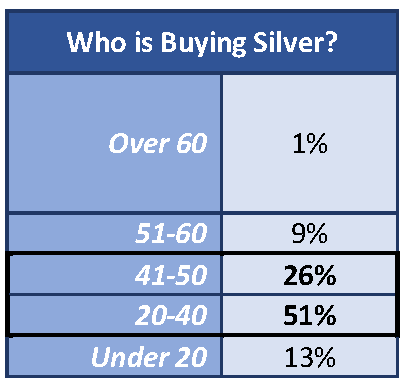Millennial Females are Purchasing More Silver Jewelry than Other Demographics
(Washington, DC — November 10, 2022) Fashion-conscious consumers cherish silver jewelry for its beauty, its use in contemporary designs, and its affordability in relation to other precious metals. Each generation plays an important yet distinct role in the silver jewelry marketplace. From the wealthy Silent Generation to the Gen Z consumer, every generation has a unique approach to silver jewelry purchases.
A new Silver Institute Market Trend Report, “Trends in Silver Jewelry Purchases,” explores the key drivers in jewelry purchase decision making and the characteristics of the silver jewelry consumer and examines silver jewelry purchases among various key demographics.
The report was commissioned by the Silver Institute and authored by The Jewelers Collective, a leading jewelry trade magazine. It examines silver jewelry purchases in the U.S. among the Silent Generation (Born 1945 or before), Baby Boomers (Born 1946-1964), Gen X (Born 1965-1976), Millennials/Gen Y (Born 1977-1995), and Gen Z (Born 1996-mid 2000’s).
The report takes a deep dive into Millennials and their jewelry spending habits and what motivates them to buy silver jewelry. The report also reviews silver jewelry trends and silver’s status versus gold jewelry purchases and concludes with a review of silver jewelry demand post COVID-19.
Of note, even when the U.S. economy was negatively impacted by COVID-19, jewelry consumers were still shopping and giving to family, friends, and themselves. There is something about the emotional embodiment found in a gift of silver jewelry that is propelling a boom in sales since April 2020. It is believed that this boom is likely to continue due to the consumer’s demand for quality and more meaningful items.
The Jewelers Collective found that in 2020, the most recent data available, the age group purchasing the most silver was females between 20-40 years old. Millennials/Gen Y purchased the most silver jewelry at 51%, followed by Gen X at 26% and Gen Z at 13%. Baby Boomers accounted for 9% and the Silent Generation totaled 1%.

The report also suggests ways for jewelers to effectively reach various demographic groups as marketing tactics vary greatly for each generation. Silents for example, respond well to traditional marketing networks, whereas Millennials are reshaping the way that goods and services are being promoted by staying somewhat unresponsive to traditional marketing tactics.
The future looks bright for silver jewelry sales as continued growth is anticipated for branded collections and online sales. The brick-and-mortar retail jeweler remains important, as does customer service, because in-store purchases are expected to account for 80 percent of silver and fine jewelry purchases by 2025.
A copy of the report can be accessed here:
# # #
The Silver Institute serves as the silver industry’s principal voice in expanding public awareness of the importance of silver to modern society. One of its primary missions is to provide the global market with reliable statistics and information on silver. The Institute’s Market Trend Reports focus on critical sectors of silver demand to bring awareness to silver’s varied and growing demand, and today’s report is part of that series. For more information on silver and the Silver Institute, please visit www.silverinstitute.org.
Recent Comments